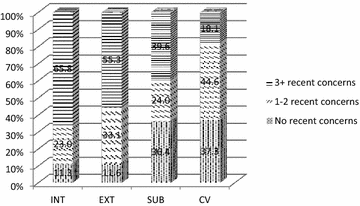Screening for substance use and mental health problems in a cross-sectoral sample of Canadian youth
- PMID: 28261324
- PMCID: PMC5331633
- DOI: 10.1186/s13033-017-0128-4
Screening for substance use and mental health problems in a cross-sectoral sample of Canadian youth
Abstract
Background: This project examines the substance use and mental health concerns of a cross-sectoral, national, service-seeking sample of adolescents and emerging adults using an extended version of the Global Appraisal of Individual Needs-Short Screener (GSS). It also aims to provide incremental evidence of the psychometric properties of the GSS.
Methods: A sample of 2313 youth aged 12-24 years who presented for service participated in the project. Youth were recruited from 89 participating services across Canada representing eight major clinical and non-clinical sectors. Participants completed the GSS and provided sociodemographic data.
Results: The majority of youth presenting for services endorsed concerns on the GSS and would be likely to meet diagnostic criteria for a disorder in a full diagnostic assessment according to the norms for the scale, while many endorsed multiple concerns. This was true in both clinical and non-clinical settings. Externalizing concerns and suicidality were significantly more common in younger participants, while substance use was significantly more common in older youth. Females were more likely to endorse internalizing and suicidality concerns, while males endorsed more substance use and crime/violence concerns. Internalizing and suicidality concerns were also more common in Canada's northerly regions. The reliability of the GSS was confirmed, however the factor structure revealed problems.
Conclusions: Youth presenting across clinical and non-clinical service sectors endorse high levels of need, supporting the importance of universal, cross-sectoral screening. The GSS is a practical tool that service providers across sectors can employ to identify the addiction and mental health service needs of youth, although further psychometric work is warranted. Implications for screening and treatment in community contexts are discussed.
Keywords: Cross-sectoral; Mental health; Screening; Substance use; Youth.
Figures







Similar articles
-
Housing Instability and Concurrent Substance use and Mental Health Concerns: An Examination of Canadian Youth.J Can Acad Child Adolesc Psychiatry. 2017 Fall;26(3):214-223. Epub 2017 Oct 1. J Can Acad Child Adolesc Psychiatry. 2017. PMID: 29056984 Free PMC article.
-
Collaborating with community-based services to promote evidence-based practice: Process description of a national initiative to improve services for youth with mental health and substance use problems.Psychol Serv. 2017 Aug;14(3):361-372. doi: 10.1037/ser0000145. Psychol Serv. 2017. PMID: 28805421
-
Program manager perspectives on the service system to meet the needs of youth with concurrent disorders: findings from a Canadian national survey.BMC Health Serv Res. 2015 Sep 18;15:393. doi: 10.1186/s12913-015-1060-4. BMC Health Serv Res. 2015. PMID: 26384786 Free PMC article.
-
Canadian Contraception Consensus (Part 1 of 4).J Obstet Gynaecol Can. 2015 Oct;37(10):936-42. doi: 10.1016/s1701-2163(16)30033-0. J Obstet Gynaecol Can. 2015. PMID: 26606712 English, French.
-
Screening and brief intervention for alcohol and other abuse.Adolesc Med State Art Rev. 2014 Apr;25(1):126-56. Adolesc Med State Art Rev. 2014. PMID: 25022191 Review.
Cited by
-
Barriers and Facilitators to the Implementation of an Integrated Youth Services Network in Ontario.Int J Integr Care. 2022 Dec 14;22(4):19. doi: 10.5334/ijic.6737. eCollection 2022 Oct-Dec. Int J Integr Care. 2022. PMID: 36569415 Free PMC article.
-
Designing digital conversational agents for youth with multiple mental health conditions: Insights on key features from a youth-engaged qualitative descriptive study.Digit Health. 2025 Mar 28;11:20552076251330550. doi: 10.1177/20552076251330550. eCollection 2025 Jan-Dec. Digit Health. 2025. PMID: 40162180 Free PMC article.
-
Pandemic impact, mitigation strategies and peer support: a qualitative analysis of youth, parent, clinician and administrator perspectives.J Eat Disord. 2025 Jul 28;13(1):157. doi: 10.1186/s40337-025-01347-2. J Eat Disord. 2025. PMID: 40722208 Free PMC article.
-
Cross-sectoral integration in youth-focused health and social services in Canada: a social network analysis.BMC Health Serv Res. 2018 Nov 28;18(1):901. doi: 10.1186/s12913-018-3742-1. BMC Health Serv Res. 2018. PMID: 30486805 Free PMC article.
-
Brief Underage Alcohol Use Screener Scores Predict Health Risk Behaviors.J Sch Nurs. 2021 Oct;37(5):323-332. doi: 10.1177/1059840519871092. Epub 2019 Aug 27. J Sch Nurs. 2021. PMID: 31455127 Free PMC article.
References
-
- Statistics Canada: Table 102-0561. Leading causes of death, total population, by age group and sex, Canada, CANSIM (database). http://www5.statcan.gc.ca/cansim/a26?lang=eng&id=1020561.
-
- Waddell C, Shepherd C, Schwartz C, Barican J. Child and youth mental disorders: prevalence and evidence-based interventions. Vancouver: Children’s Health Policy Centre, Faculty of Health Sciences, Simon Fraser University; 2014. p. 15.
LinkOut - more resources
Full Text Sources
Other Literature Sources
Miscellaneous

